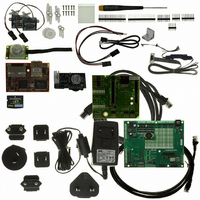101-1121 Rabbit Semiconductor, 101-1121 Datasheet - Page 25

101-1121
Manufacturer Part Number
101-1121
Description
KIT CAMERA INTERFACE APPLICATION
Manufacturer
Rabbit Semiconductor
Series
RabbitCore 3000r
Specifications of 101-1121
Sensor Type
Motion, PIR (Pyroelectric Infrared)
Interface
10/100 BaseT Ethernet
Embedded
Yes, Other
Utilized Ic / Part
RCM3365
Interface Type
Ethernet
Lead Free Status / RoHS Status
Contains lead / RoHS non-compliant
Voltage - Supply
-
Sensitivity
-
Sensing Range
-
Lead Free Status / Rohs Status
Lead free / RoHS Compliant
Other names
316-1119
- Current page: 25 of 164
- Download datasheet (3Mb)
3.1 Introduction
To help familiarize you with the RCM3365 and RCM3375 modules, Dynamic C includes
several sample programs. Loading, executing and studying these programs will give you a
solid hands-on overview of the RCM3365/RCM3375’s capabilities, as well as a quick
start using Dynamic C as an application development tool.
More complete information on Dynamic C is provided in the Dynamic C User’s Manual.
In order to run the sample programs discussed in this chapter and elsewhere in this manual,
1. Your RCM3365/RCM3375 module must be plugged in to the Prototyping Board as
2. Dynamic C must be installed and running on your PC.
3. The RCM3365/RCM3375 module must be connected to your PC either through the
4. Power must be applied to the RCM3365/RCM3375 through the Prototyping Board.
Refer to Chapter 2, “Getting Started,” if you need further information on these steps.
Since the RCM3365 and the RCM3375 run at 44.2 MHz and are equipped with a fast pro-
gram execution SRAM, remember to allow the compiler to run the application in the fast
program execution SRAM by selecting
Dynamic C
To run a sample program, open it with the
pile and run the program.
User’s Manual
described in Chapter 2, “Getting Started.”
serial programming cable or through an Ethernet cable/network if you have a
RabbitSys-enabled RCM3365.
To develop and debug programs for the RCM3365/RCM3375
(and for all other Rabbit hardware), you must install and use
Dynamic C.
NOTE: The sample programs assume that you have at least an elementary grasp of the C
programming language. If you do not, see the introductory pages of the Dynamic C
User’s Manual for a suggested reading list.
Options > Project Options > Compiler
3. R
UNNING
Code and BIOS in Flash, Run in RAM
File
S
menu, then press function key
AMPLE
menu.
P
ROGRAMS
F9
from the
to com-
19
Related parts for 101-1121
Image
Part Number
Description
Manufacturer
Datasheet
Request
R

Part Number:
Description:
KIT DEV FOR BL2500 COYOTE
Manufacturer:
Rabbit Semiconductor
Datasheet:

Part Number:
Description:
KIT APPLICATION SIMPLE SENSOR
Manufacturer:
Rabbit Semiconductor
Datasheet:

Part Number:
Description:
KIT APPLICATION LCD COLOR INT'L
Manufacturer:
Rabbit Semiconductor

Part Number:
Description:
IC CPU RABBIT2000 30MHZ 100PQFP
Manufacturer:
Rabbit Semiconductor
Datasheet:

Part Number:
Description:
IC CPU RABBIT4000 128-LQFP
Manufacturer:
Rabbit Semiconductor
Datasheet:

Part Number:
Description:
IC MPU RABIT3000A 55.5MHZ128LQFP
Manufacturer:
Rabbit Semiconductor
Datasheet:

Part Number:
Description:
MODULE RABBITCORE RCM4010
Manufacturer:
Rabbit Semiconductor
Datasheet:

Part Number:
Description:
RCM4110 RABBITCORE
Manufacturer:
Rabbit Semiconductor
Datasheet:

Part Number:
Description:
MODULE RABBITCORE RCM2000
Manufacturer:
Rabbit Semiconductor
Datasheet:

Part Number:
Description:
MODULE RABBITCORE RCM3000
Manufacturer:
Rabbit Semiconductor
Datasheet:

Part Number:
Description:
MCU RCM4000 RABBITCORE
Manufacturer:
Rabbit Semiconductor
Datasheet:

Part Number:
Description:
MODULE RCM4210 RABBITCORE
Manufacturer:
Rabbit Semiconductor
Datasheet:

Part Number:
Description:
MODULE RCM4200 RABBITCORE
Manufacturer:
Rabbit Semiconductor
Datasheet:

Part Number:
Description:
MODULE RABBITCORE RCM2020
Manufacturer:
Rabbit Semiconductor
Datasheet:











